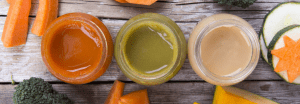
A new way to introduce solids to your baby is becoming more and more popular. Baby led weaning is making meal time look a lot different than the typical baby jar food puree and a spoon.
What is Baby Led Weaning
Baby led weaning, BLW, bypasses purees altogether and teaches your baby to self-feed instead. Babies six months or older jump straight into finger foods as soon as solids are introduced. In a sense, they are skipping purees and jar food altogether. You are essentially letting your little one feed themselves from the start.
This technique will only work on babies who are at least six months old and capable of feeding themselves. This allows babies to learn the process of chewing and swallowing their food. This method also helps to prevent parents from pushing food onto babies when they may be full, as the baby is in charge themselves.
When to Start to BLW
When beginning to baby led wean, it is important that your baby is able to sit up by themselves. They should also be able to grab and hold onto objects. Around six months your baby should have also dropped the tongue-thrust reflex, that causes them to push foreign substances out of their mouth. Their intestines are also able to absorb and digest solid food by this age.
Why Do Baby Led Weaning
There are quite a few benefits when it comes to this route of introducing solids to your baby:
- Learning to chew. Chewing helps aid in your baby’s digestion. This will also help them prepare for bigger foods in the future.
- New textures. Your baby will become familiar with a variety of different textures and flavors compared to babies eating purees. This may result in your baby having a preference towards healthier foods in the future. Research also suggests they may have fewer food allergies in life.
- Better hand-eye coordination. By feeding themselves from the very beginning your baby will develop a stronger sense of hand-eye coordination skills, as well as dexterity.
- Less likely to overeat. Your baby will know when they are full and will stop feeding themselves once they are satisfied. Spoon feeding your infant can result in overfeeding and lead to being overweight later on in life.
Concerns with Baby Led Weaning
There are a few things that you should consider while deciding if BLW is best for you:
 The mess. Letting your baby feed themselves with their hands can get pretty messy. If you like to have a clean area at all times this may not be the route for you. Your baby will be learning how to eat the foods, but also how to get it into their mouth. So it may result in a very messy floor and high chair.
The mess. Letting your baby feed themselves with their hands can get pretty messy. If you like to have a clean area at all times this may not be the route for you. Your baby will be learning how to eat the foods, but also how to get it into their mouth. So it may result in a very messy floor and high chair. - Choking concern. You will still need to watch your baby. Even though your baby will be feeding themselves, you need to be close by to watch and intervene if it looks like your baby will choke. Make sure that all of the food you have prepared for them is cut into very small bites and monitor how much your baby will put in their mouth at a time. They may need to go more slowly with some textures than others as they explore their new world of food.
- Pay attention to the iron. Some pediatricians will recommend adding an iron supplement to their food. As it can be hard for babies to receive all of the iron that they need from breastmilk and foods after six months. Foods that are rich in iron can also be harder for your baby to chew at the beginning.
Tips to Begin your BLW Journey
Starting your baby on foods that aren’t pureed can feel a little nerve wracking at first. However, there are a few tips that you can follow to help make the process safer and easier:
- Prepare for the mess. Perhaps set up a “mess approved area”. Try putting some plastic or something easy to clean underneath your baby’s high chair and invest in a large bib. You could even strip your little one down to their diaper to help avoid the mess on their clothes while eating.
- You don’t need a schedule. Baby led weaning can be very convenient for you if you offer them food during your own mealtimes. This will help to start off a family meal time from the very beginning. Let your baby decide if they are hungry when you offer the food and go from there.
- Continue to nurse or bottle feed. Try and maintain the same amount of feedings that you have been before introducing solids. Your baby will still get the majority of their nutrients from breast milk or formula throughout their first year of life.
- Do not rush things. Much like how you would begin with pureed food, you will want to start your baby off slowly. Offer only one type of food at a time. Try to begin with one or two pieces at a time to help monitor how much they are putting in their mouths to avoid a choking hazard.
- Cut food into tiny pieces. Make sure that any food you offer your baby has been cut up in easy to chew pieces beforehand. You don’t need to use plates or bowls, just put it directly on a placemat in front of them.
- Variety is key. Once your baby has had their initial exposure to new foods, try to introduce a variety of different options. This will allow you and your baby to explore what types of foods they enjoy and which aren’t for them. Make sure to offer them healthy foods such as steamed green beans, sweet potatoes, whole wheat bread, and even whole grain pasta.
- Try the same meals. After your baby has gotten used to BLW you can introduce the same meal that you are having to them. This will help you to avoid preparing different meals and make mealtime easier altogether!
- Have fun! We know the old saying is, “Don’t play with your food.” But now is the time to play with their food! Let them enjoy exploring new textures and tastes. This will help them to enjoy mealtime and to become more comfortable with the foods you are offering.
- Don’t push it on them. BLW is designed for your little one to be in charge. If they do not want to eat all of the food you have given them or even any at all that is okay. Let them set the pace. Your baby is developing a taste for what they like and do not like. As long as you are still nursing or bottle feeding your baby is still getting the nutrition that they need.
Foods to Use
Make sure that you are choosing foods for your baby that are high in zinc, protein, iron, and healthy fats.
Begin with soft foods first such as:
 Ripe fruits
Ripe fruits- Cooked egg yolks
- Flaky fish (be extra vigilant doing this as it could be an allergen)
- Moist and shredded meats (make sure to remove any bones)
- Puffed cereals
- Cooked pasta
- Cooked vegetables
Other great options for BLW are :
- Whole wheat toast with hummus
- Avocados
- Yogurt
- Sweet potato fries
- Banana
- Cottage cheese
Try and avoid foods with sugar or artificial sweeteners as they do not add any nutritional value. Consistent use of salt or sugar will set kids up to prefer salty or sugary foods in the future. So skip the cookies, chips, and other prepackaged foods as they tend to stray away from nutrients and have additives and unhealthy trans-fat.
Things to Avoid while BLW
Here are a few things to avoid and things to look out for while BLW:
- Don’t rush your baby. Allow your baby time to play with their food and explore. Meal times should take at least ten to 15 minutes.
- Be vigilant for choking hazards. Stay away from choking hazards such as hot dogs, raisins, popcorn, grapes, raw vegetables, and sticky nut butters. It is a good idea to learn the infant-specific Heimlich maneuver as a precaution. Always stay with your baby while they are eating.
- Avoid hot foods and sharp utensils. Make sure that all warm food has been cooled to room temperature to avoid your baby burning their hands or mouths. Also avoid sharp utensils your baby should be using their hands to feed themselves with BLW.
- Accept that it may not be for you. It is okay to decide BLW is not for you or your baby after trying it. Every baby is different and it is okay to change your mind if you want to.
- Gagging vs. choking. If your baby is gagging they may appear to be coughing mildly and make a little noise. If they are choking they will look terrified, be unable to breath and make no noise. HELP YOUR BABY RIGHT AWAY IF THIS IS THE CASE.
- If they are gagging they can usually handle the problem themselves, remain calm and offer your baby calming techniques. Gagging will ease up as the baby learns to cope with solids and lumps.
- Make sure your baby is always upright. To help avoid choking, make sure your baby is always sitting upright while eating.
- Watch out for allergic reactions. The more options you offer your little one the more they will accept different foods. But when giving them foods that may result in an allergy keep a close eye on them.


